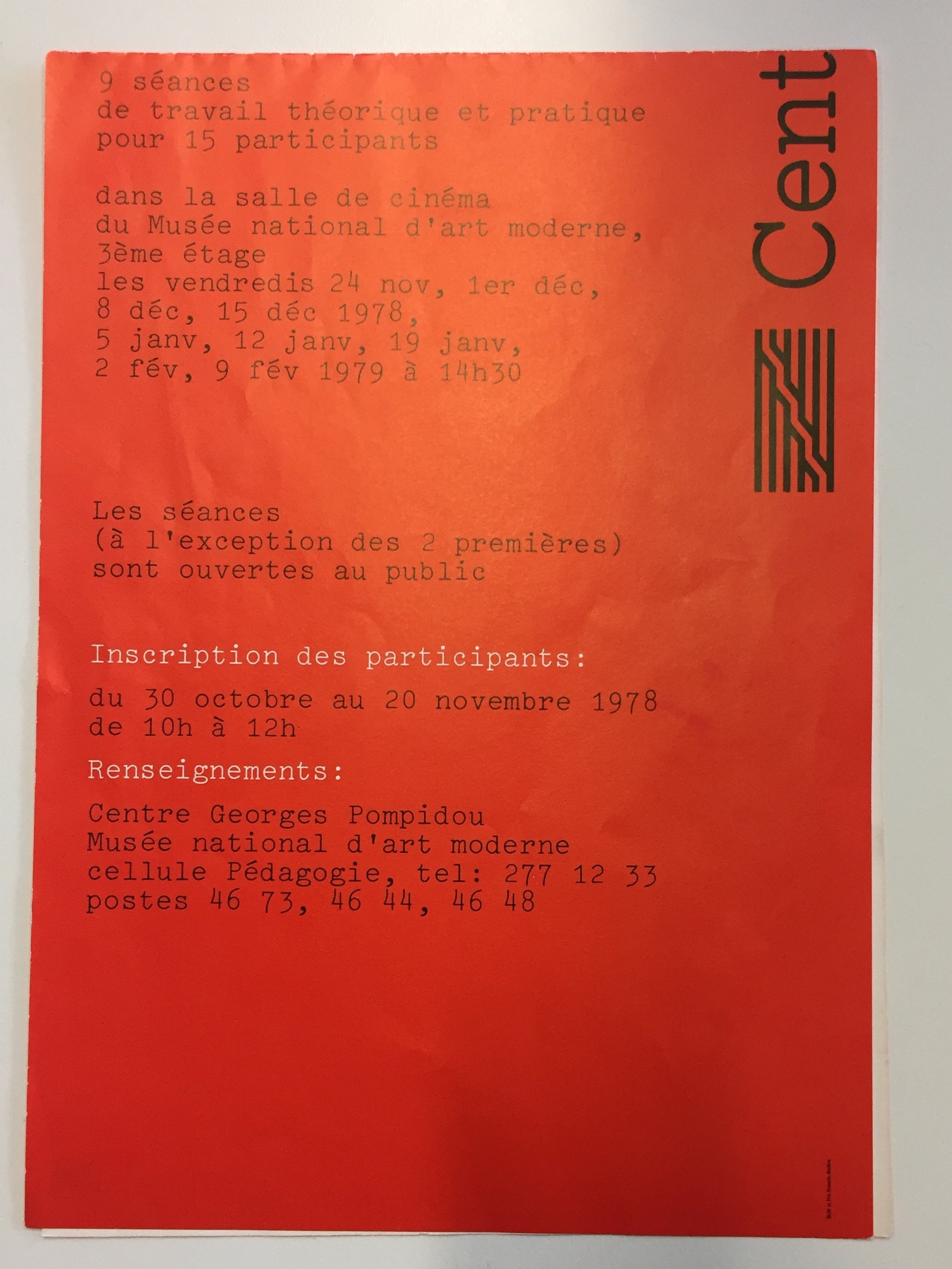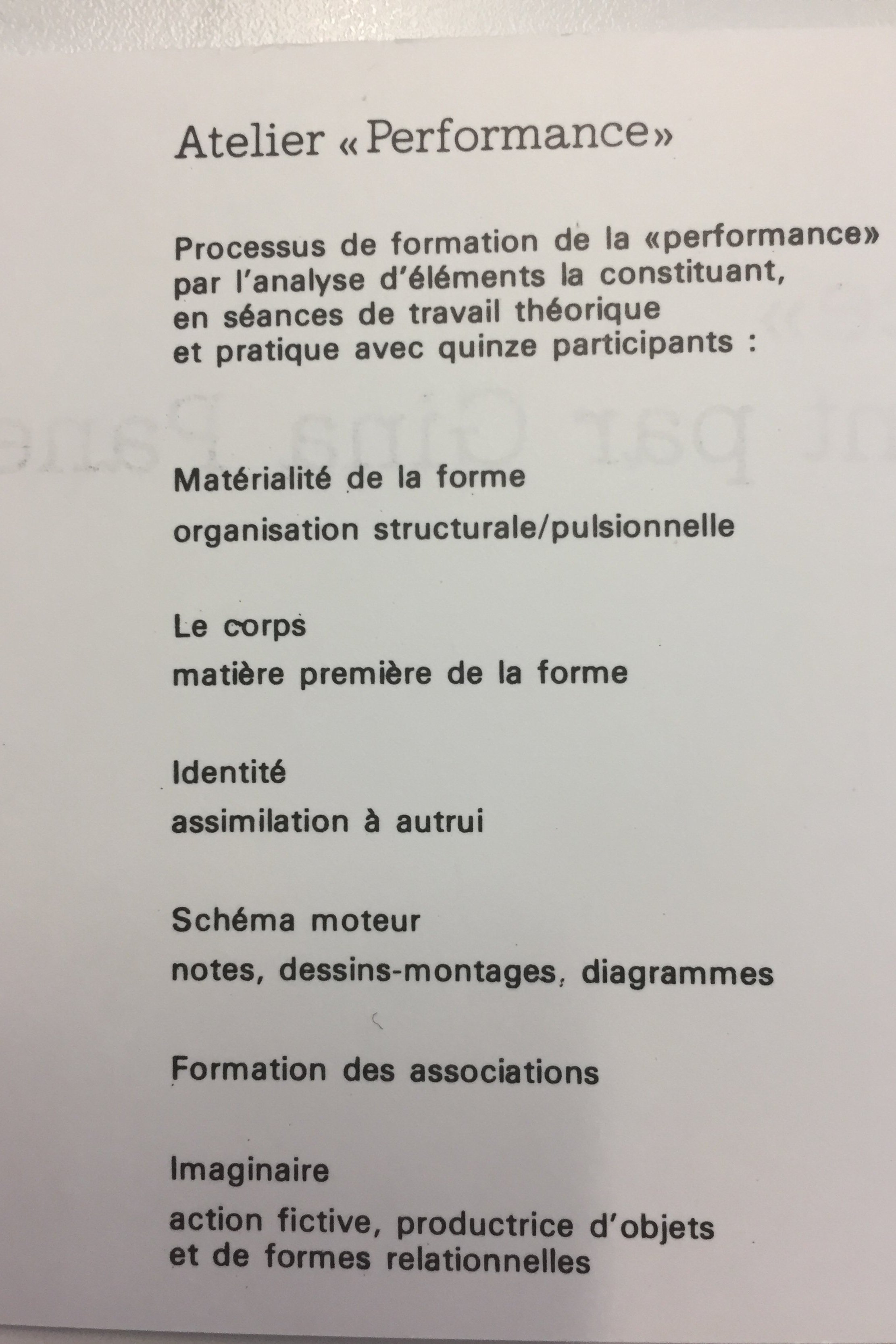Research Dossier, underway: en cours (2018)
Kandinsky Library, MNAM / CCI, Center Pompidou - Dist. RMN-Grand Palais, Atelier performance, cycle d'enseignement par Gina Pane au Centre Pompidou, salle cinéma (24 novembre 1978 - 9 février 1979) : prises de vues. Photographer: Jacques Faujour
initial motivation
I am often confronted with the question: How does a performance artist use a studio? (a space generally organized, designed, and conceptualized for fine artists). Because my final performances are often site-specific works that occur in public space, Underway: En Cours has allowed me to generate discourse about the difference between daily embodied practice and live performance. It has also been an investigation of the (in)visible labor that occurs in the “workshop” and a physical dialogue with a history of queer feminist work that pioneered new artistic concepts and practices during the performative turn to the body in the 1970s.
From the outset, I was specifically interested in:
1) Pane’s specific workshop as it provokes consideration of the labor of queer women artists who transmit embodied knowledge beyond their individual oeuvres
2) the archive of photographs and materials generated during the workshop as an archive of artistic praxis and process
3) working between Pane’s workshop and my “atelier” in ways that amplify the daily labor of a performance artist at work
archives
The evolution of performance art is often appreciated and interpreted through the documentation of key works that have been archived, written about, and sometimes re-performed. This practice-based research project seeks to complicate these strategies by centering on the immaterial labor a performance workshop and/or daily studio praxis cultivates. Workshops are crucial sites for developing a rigorous artistic practice. Workshops also enable a deeper understanding of the kind of labor, training, and aesthetic strategies honed by performance artists. The studio provides a similar atmosphere, but it is not often considered to be a space for performance artists. Creating this work in a larger artistic residency helped to highlight and rupture some conceptions about performance art and the work of the performance artist. Where does her labor happen? What spaces are available and amenable to the kind of labor she needs to do? What is different about a daily practice and a praxis that is geared toward the realization of a specific performance?
Working from the photographs of the 78-79 workshop, allowed me to approach these questions about invisible labor, anachronistic temporality, and the development of performance art as a medium with a queer feminist history and lineage. The daily work somehow placed me as a participant in Pane’s workshop, as an embodied translator of performance processes that exceed the bounds of written histories and final productions, and as an author to my own studio practice and the discoveries I made.
Kandinsky Library, MNAM / CCI, Center Pompidou - Dist. RMN-Grand Palais, Atelier performance, cycle d'enseignement par Gina Pane au Centre Pompidou, salle cinéma (24 novembre 1978 - 9 février 1979) : prises de vues.
Kandinsky Library, MNAM / CCI, Center Pompidou - Dist. RMN-Grand Palais, Atelier performance, cycle d'enseignement par Gina Pane au Centre Pompidou, salle cinéma (24 novembre 1978 - 9 février 1979) : prises de vues.
focus
To create something that is learning from, doing, and teaching at the same time
To explore the space of the “atelier” as doubly a “studio” and “workshop”
To cite the lineages of performance art that matter to my practice while also exceeding the bounds of the archive. For this project, archival materials offer context and a starting point but no destination (The project is not interested in “re-performance”)
To bring visibility to the daily work of sustaining an artistic practice
aims
To subvert and question the value institutions place on the “re-performance” of previous works, by generating something invested in an archive of how practice practices
To resist the desire to create a performance
To share how I practice instead of what I am making (how a performance artist practices instead of what the performance artist makes)
materials
anything found, abandoned, or left behind (ink, paint, screws, glass, eggs, paper, string, wood, towels, paper, bottles, pitcher, plastic, tiles, hooks, wire, honey, drop cloth, chalk, photographs), Archival photographs from The Kandinsky Library at Centre Pompidou
One aspect of the project was to avoid purchasing materials and use found objects. This was motivated by the archival materials, the common assumption that a performance workshop or daily practice does not require a budget for materials, and the reality that I had no such budget
documentation practices
- daily writing
- time-lapse photos
- videos
- materials as documents (my materials become a new archive)
basic structure
1) Archival Research (2 Weeks)
a. I began by digging through the archival materials at Centre Pompidou. During this initial period of research I got acclimated to my studio, which was also my living space for the duration of the project.
b. I found 873 photographs of the 78-79 Pompidou in the archive (from workshops 3-9, there are no photographs of workshops 1-2).
c. I also found Pane’s outline for the workshops, including a list of requested materials.
d. Once I found the photographs from the workshop, they became the primary material for the research and practice
2) Performance Research (9 Weeks)
a. The notion of the “sequence” became an important frame for me. I arrived to this notion a few different ways:
i. Pane was herself an artist that exhibited the documentation of her live performances through sequences of photographs taken by her partner Anne Marchand.
ii. I desired to work with the archival materials in a non-linear manner and create sequences that contained one photograph from workshops 3-9 (workshops 1-2 were not photographed).
iii. Once I’d selected the 7 photographs for a sequence, I sketched and wrote a performance score for each photograph.
iv. 5 scores would be realized during my daily practice (one score per day for periods of 1-8 hours).
v. Two scores would disappear from the live work.
1. Not knowing what discoveries I would make during any day’s praxis, this allowed me flexibility while limiting the sequences enough so I could focus on the practice without going back to all the photographs every day.
2. This choice resonated with the materials from the workshop, which also exist as an incomplete record of the workshop.
Kandinsky Library, MNAM / CCI, Center Pompidou - Dist. RMN-Grand Palais, Atelier performance, cycle d'enseignement par Gina Pane au Centre Pompidou, salle cinéma (24 novembre 1978 - 9 février 1979) : prises de vues.
Kandinsky Library, MNAM / CCI, Center Pompidou - Dist. RMN-Grand Palais, Atelier performance, cycle d'enseignement par Gina Pane au Centre Pompidou, salle cinéma (24 novembre 1978 - 9 février 1979) : prises de vues.
b. Basic Structure: SEQUENCE
i. I created six sequences by using Pane’s outline for the workshop (pictured above).
ii. Each sequence consisted of seven new scores for daily practice
iii. Only five of the seven new scores would be activated, with two unrealized scores per sequence
iv. Six sequences of five made up the 30 days of daily practice, two days of each week were then reserved for writing, reflecting, and selecting the next sequence of images for the following week…
1. in my initial plan was for six weeks, which would have allowed me more time in residence to return to the archive and work on writing up my notes and reflections etc.
2. The daily practice actually began on 4/18 and ended 6/24, taking approximately nine weeks to accomplish 42 days of practice (30 performing/12 that were set aside as writing/research/rest for the physical body)
3. I’m questioning the relevance/significance of this…What could it say about the ability to sustain artistic practice with demands of daily life?
3) Future Steps
a. There is more research to do about the 78-79 workshop. Not only its particular political moment, but also its relevance to a larger history of the development of performance art
b. Typing up notes, organizing documentation, making final decisions about the physical materials and how to archive and disseminate
c. Organizing the videos, timelapse, and photographs for critical-creative circulation




